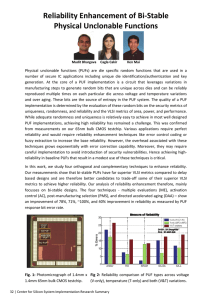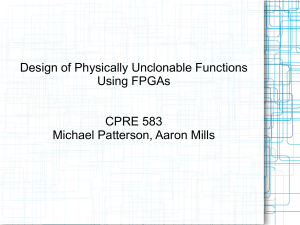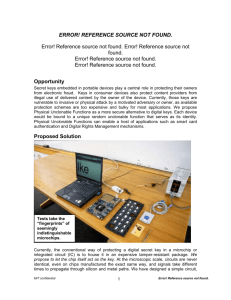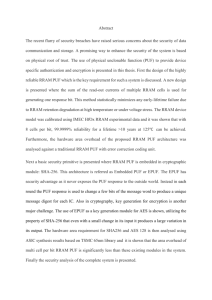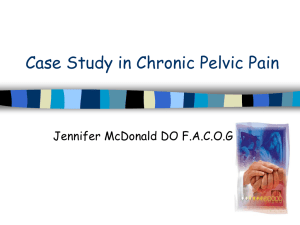Maximum-likelihood decoding of device-specific multi-bit symbols for reliable key generation Please share
advertisement
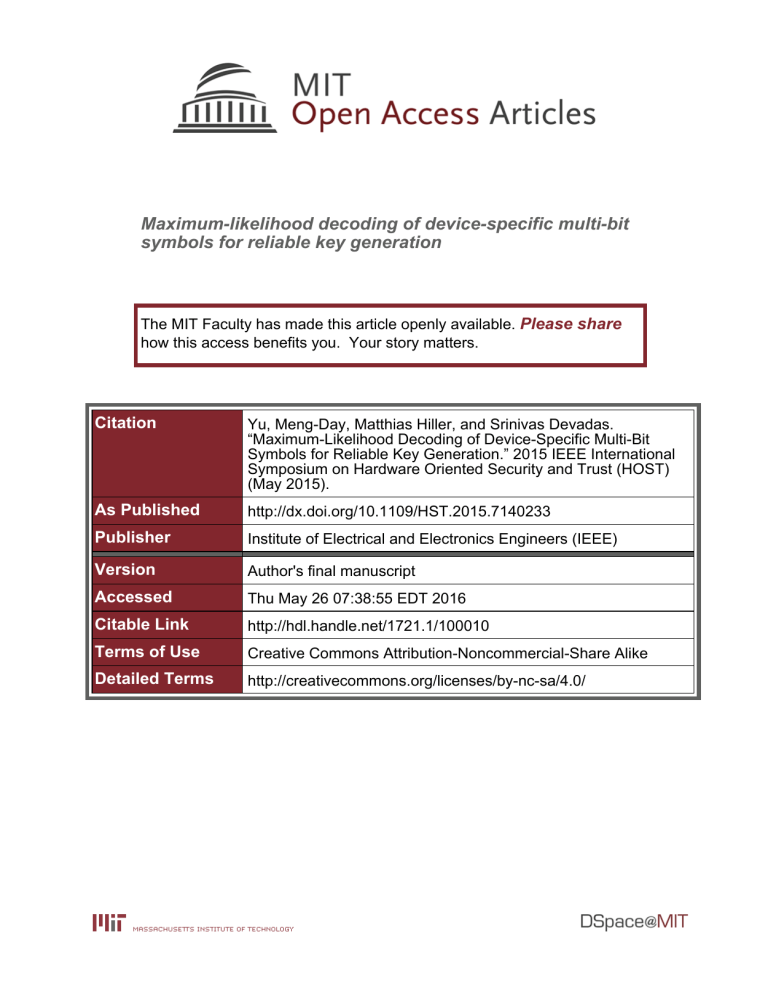
Maximum-likelihood decoding of device-specific multi-bit
symbols for reliable key generation
The MIT Faculty has made this article openly available. Please share
how this access benefits you. Your story matters.
Citation
Yu, Meng-Day, Matthias Hiller, and Srinivas Devadas.
“Maximum-Likelihood Decoding of Device-Specific Multi-Bit
Symbols for Reliable Key Generation.” 2015 IEEE International
Symposium on Hardware Oriented Security and Trust (HOST)
(May 2015).
As Published
http://dx.doi.org/10.1109/HST.2015.7140233
Publisher
Institute of Electrical and Electronics Engineers (IEEE)
Version
Author's final manuscript
Accessed
Thu May 26 07:38:55 EDT 2016
Citable Link
http://hdl.handle.net/1721.1/100010
Terms of Use
Creative Commons Attribution-Noncommercial-Share Alike
Detailed Terms
http://creativecommons.org/licenses/by-nc-sa/4.0/
Maximum-Likelihood Decoding of Device-Specific
Multi-Bit Symbols for Reliable Key Generation
Meng-Day (Mandel) Yu∗†§ , Matthias Hiller‡ , Srinivas Devadas§
∗ Verayo,
Inc., San Jose, CA, USA
myu@verayo.com
† COSIC / KU Leuven, Belgium
‡ Institute for Security in Information Technology / Technische Universität München, Germany
matthias.hiller@tum.de
§ CSAIL / MIT, Cambridge, MA, USA
devadas@mit.edu
Abstract—We present a PUF key generation scheme that
uses the provably optimal method of maximum-likelihood (ML)
detection on symbols derived from PUF response bits. Each
device forms a noisy, device-specific symbol constellation, based
on manufacturing variation. Each detected symbol is a letter in
a codeword of an error correction code, resulting in non-binary
codewords.
We present a three-pronged validation strategy: i. mathematical (deriving an optimal symbol decoder), ii. simulation
(comparing against prior approaches), and iii. empirical (using
implementation data). We present simulation results demonstrating that for a given PUF noise level and block size (an
estimate of helper data size), our new symbol-based ML approach
can have orders of magnitude better bit error rates compared
to prior schemes such as block coding, repetition coding, and
threshold-based pattern matching, especially under high levels of
noise due to extreme environmental variation. We demonstrate
environmental reliability of a ML symbol-based soft-decision
error correction approach in 28nm FPGA silicon, covering -65◦ C
to 105◦ C ambient (and including 125◦ C junction), and with 128bit key regeneration error probability ≤ 1 ppm.
Index Terms—Physical Unclonable Function, MaximumLikelihood, Non-Binary Codewords, Soft-Decision, Key Generation
I. I NTRODUCTION
Silicon Physical Unclonable Function (PUF) [8] [9] circuits
exploit CMOS manufacturing variation in security applications, allowing a silicon device to be authenticated based
on a challenge/response evaluation of difficult-to-replicate
manufacturing variation. Since evaluation of a PUF response
is physical, PUF response bits are noisy and noise increases
with environmental variation. For a key generation use case,
the basic PUF circuit needs error correction to account for
evaluation noise; this requires helper data.
Figure 1 offers a codeword-centric view of PUF error
correction, using code-offset helper data [6] [12]. During
provisioning, keying material KM is used as input to an error
correction code (ECC) encoder to produce a codeword CW .
The codeword is bit-wise XOR’ed with a reference query of
the PUF response RS, and stored as helper data HD. During
regeneration, HD enables the return of a noisy query of the
PUF response RS 0 back to a codeword with noise CW 0 ; the
KM
ECCEnc
KM
CW
RS
PUF
ECCDec
HD
CWʹ
RSʹ
HD
PUF
Fig. 1. PUF error correction using code-offset for provisioning (left) and
regeneration (right): HD relates RS 0 to CW 0 to allow error decoding.
regenerated PUF response is transformed into a form where
ECC decoding can be applied to remove noise. In effect,
PUF is used to “store” KM using chip-unique manufacturing
variation where KM can be hashed/down-mixed into a key
(hash not shown in Figure).1
It is natural to think of codewords as composed of binary
values vs. symbols from a higher-order alphabet. In our
work, we perform PUF error correction using symbol-level
(vs. bit-level) recovery and non-binary codewords. Our proofof-concept Maximum-Likelihood Symbol Recovery (MLSR)
implementation reduced bit errors to ∼ 0.01% at a 125◦ C
key regeneration junction temperature (provisioning at room
temperature), and produced a soft-decision metric that allows
a simple soft-decision decoder to “mop up” remaining errors.
Our soft-decision symbol parity decoder also uses ML decoding and corrects the most-likely corrupted symbol based
on the least distance between the most-likely and 2nd -mostlikely symbols, reducing the ∼ 0.01% bit failure rate to show
an empirical key regeneration failure rate ≤ 1 × 10−6 .
A. Contributions
The main contributions of the current work are:
• first to use ML symbol-based decoding on PUF bits
• first PUF error correction scheme capable of orders
of magnitude bit error improvement over the standard
repetition coding and BCH approaches
1 Figure 1 assumes an externally chosen secret [12]. Using the syndrome
construction [6], the secret (i.e., KM ) can be internally derived, from RS.
•
x1
x0
new method to help counter recent helper data attacks
based on linear-XOR or linear-shift malleability
xk-2
xk-1
xk-1
y
B. Organization
Section II provides background. Our MLSR method is
described in Section III, and validated in Section IV using a
three-pronged (mathematical, simulation, empirical) approach.
Section V covers recent helper data manipulation attacks
which MLSR helps to address. We conclude in Section VI.
x0
x1
xk-2
osc0
+ osc2
osc2k-4
+ osc2k-2
count
top delay
II. BACKGROUND
osc1
+
osc3
osc2k-3
+ osc2k-1
count
bot. delay
PUF
A. Related Work
PUF Key Generation. Silicon PUF key generation was first
introduced using Hamming codes in [9] and more details
were presented in [22]. More practical implementations that
accounted for a wider range of environmental variation were
described in [1] [16] [23] [19] [24] [17] [14] [11]. The recent
results in [18] at 22nm have restricted temperature data (25◦ C
to 50◦ C) that does not cover many operating conditions.2
Helper Data Manipulation. The issue of helper data manipulation was addressed for the biometric realm in [2] [7], with
robust fuzzy extractors, but not so much in a manner specific
to silicon PUFs. Their use of a helper data hash does not
address recent helper data manipulation attacks in [13] [5]. A
more recent work [11] also addresses helper data manipulation
and in the context of a PUF but requires a hash function.
Maximum-Likelihood (ML). ML is a provably optimal decoding method used to recover bits transmitted over a noisy
physical medium [20]. Repetition coding, which was used for
PUF key generation in [1] [17] [14], uses a decoder that can
be interpreted as ML with (degenerate) one-bit symbols. A
recent publication [11] uses ML for 2nd stage decode but not
1st . We are the first to apply ML on multi-bit symbols, and to
do so early on, during the 1st stage, which results in orders
of magnitude bit error improvements over standard methods.
B. PUF Building Blocks
Arbiter PUFs. Arbiter PUFs were introduced in [15] (Figure
2, top). PUF output is derived from a race condition formed
by successive delay stages each comprising a crossbar switch.
A challenge bit xi , 0 ≤ i < k − 1, for each of the k stages
determines whether the parallel path or cross path is active.
Collectively, k challenge bits determine which path is chosen
to create the transition at the top input to the arbiter latch, and
similarly for bottom input. The difference comparison between
the two delays determines whether the PUF produces a “1”
vs. “0” response bit. Design layout has to be symmetrically
matched such that random manufacturing variation would
affect the response.
k-sum Ring Oscillator PUFs. In a k-sum PUF [24], each
of k stages is replaced with a pair of identically manufactured
ring oscillators (Figure 2, middle). Delay propagation is mimicked by digitally adding delay values for each stage depending
on the challenge bit associated with that stage. Mathematically,
2 Typical commercial (junction) temperature range: 0◦ C to 85◦ C; for
industrial: -40◦ C to 100◦ C; and for military: -55◦ C to 125◦ C.
>
y
PUF
x0,0…x k-1,0
0,1
PUF
k-1,1
x …x
PUF
0
1
y0
y
1
y
n-1
0,n-1
x
…x
k-1,n-1
n-1
y
PUF
n-XOR PUF
Fig. 2. Basic Arbiter PUF (top); k-sum Ring Oscillator equivalent (middle);
n-XOR construction (bottom).
k-sum PUF and Arbiter PUF can be reduced to the same
topology by a linear remapping of the challenge bits [21].
C. n-XOR Construction
The basic Arbiter PUF (and its equivalent k-sum PUF)
can be modeled using machine learning attacks [21] when
a sufficient number of challenge/response pairs (CRPs) is
exposed. To scale up security against modeling attacks, XORs
can be applied to outputs from n copies of these manufacturing
variation building block primitives (Figure 2, bottom), to
require more CRPs, computational power, time, etc. to model
the composite n-XOR PUF.
III. M AXIMUM -L IKELIHOOD S YMBOL R ECOVERY
A. Adapting n-XOR PUF for Key Generation
The n-XOR PUF, in its native form, is an “open system”
in that user and adversary alike have unrestricted access to its
challenge/response interface. When used for authentication,
the number of exposed CRPs is potentially very large, easily
in the millions or billions, making the PUF susceptible to machine learning predictive attacks. Fortunately, in our specific
key generation use case (similar to [19]), we generate a fixed
number of keying bits from the PUF, thus we reveal only a
limited number of response bits to the adversary, e.g., several
thousand bits.
Our implementation uses 4-XOR (programmable to more)
and exports ≤ 3000 response bits as helper data for a 128-bit
key.3 Multiple research groups with attacks spanning 3+ years
[21] [4] require more than 3000 CRPs to break 4-XOR PUF.
3 The
entire challenge schedule, starting from the seed, is hardwired.
ML
decision boundary
(optimal)
bounded-distance/
seqa
threshold-based
decision boundary
s[0]
s
KM
seqʹ
RS
PUF0
seqʹʹ
seqb
PUF0
RSPUF1
PUF1
s[1]
PUF2
2
RS
PUF
a
PUF3
RS
3
Fig. 3. ML vs. bounded-distance/threshold-based: seq 00 decodes correctly
for both approaches but seq 0 decodes properly only for ML.
PUF
s
xresp
s[2]
HD
PUF4
4
RS
PUF
a
5
B. ML vs. Bounded-Distance/Threshold-Based
We offer two explanations why ML has a lower error probability than a bounded-distance decoding approach associated
with most PUF block decoders (e.g., BCH) [1] [23] [17], and
equivalently for a threshold-based approach [19]:
1) Visual: Figure 3 shows two sequences, with the goal
of deciding whether a received sequence belongs to seqa
or seqb . In bounded-distance/threshold-based decode, seq 00
decodes properly to seqb , since it is within a certain preset
distance or threshold represented by the circle around seqb . On
the other hand, seq 0 decodes improperly since it falls outside
the circle. In ML, since seq 0 is closer to seqb than to seqa (i.e.,
falls to the right of dotted line), even though it falls outside
the circle, it still decodes properly to seqb .
2) Toy Example: Let seqa = 1010101, and seqb =
1010010. If a received sequence is 0101010, although 4 out of
7 bits have flipped with respect to seqb , ML decodes to seqb
since received sequence is closer to seqb than seqa .
C. Device-Specific Symbols with Ease of ML Decode
We treat PUF response bits as l-bit sequences through which
we encode and decode α-bit symbols. This is done for β
processing blocks. Now, we establish some notation.
i
• PUF is a basic PUF building block (with no XOR), PUF
th
is the i PUF instance.
• KM is keying material, HD is helper data (l · β bits).
P UF i
• RS is a response sequence of l bits, and RS
is a
th
l-bit response sequence from i PUF.
0
00
• s is an α-bit symbol. s is the ML recovered version. s
is the second-most-likely recovered version.
s
• xresp is the l-bit response sequence (helper data block)
obtained after all RS P U F ∗ selected using s are XOR’ed.
?
• xresp is helper data block read back into the decoder.
0
• prime means a value derived during regeneration.
0
• c is soft-decision confidence information for a symbol.
Now, we shall encode in a manner that yields a simple ML
decoder. We give an α=4-bit example:
1) Symbol Encoder: HD is a function of symbol bits
(derived from KM ) and RS from multiple PUFs. Symbol
bits s[0...3] each drive a mux select line of a two-bit to onebit mux (Figure 4, top). The construction looks like n-XOR
PUF except 2:1 muxes are used to select which PUF response
RS P U F ∗ to use prior to the XOR function. The XOR’ed l-bit
result, denoted xresps , forms the helper data HD for one
symbol. Encoder uses four 2:1 muxes and one XOR gate.
PUF5
RS
PUF
s[3]
PUF6
6
RS
a
RS
PUF
7
PUF
PUF7
SYenc
1st likely
symbol
s?
sʹ
+
1
(xrespʹ)s?
xresp?
2nd nearest
distance
+
-
-
SYenc
Fig. 4.
HD
cʹ
st
1 nearest
SYdec
distance
4-bit Symbol Encoder (top), 4-bit MLSR Symbol Decoder (bottom)
2) Symbol Decoder: Figure 4, bottom, depicts a symbol
decoder, which contains a symbol encoder. The helper data
from encoding xresps is read in as xresp? since the symbol
has yet to be recovered. To perform ML decoding, a 4-bit
counter is used to iterate through all 16 symbols (indicated by
s?), and the most likely symbol is stored. The symbol with
minimum distance is found by performing bit-wise XOR of
xresp? (from HD) and candidate regenerated l-bit sequence
(xresp0 )s? representing a symbol,4 and incrementing a counter
whenever a bit mismatch is seen (using one XOR gate and one
log2 (l)-bit adder). A comparator (subtractor) is used to find
1st nearest distance and 2nd nearest distance (uses two stage
buffering of log2 (l) bits each), and their difference (using a
subtractor) computes soft-decision confidence c0 .
A 4-bit symbol encoder/decoder with l=128 bits requires 12
SLICES (440 gate equivalents) in a Xilinx Artix-7 FPGA.
D. 4-bit Symbol Encoder / Decoder Pseudo-Code
Here, ⊕ is bit-wise XOR, (.)? is an if-then-else statement,
and wt is the Hamming weight operator counting the number
of 1s. Note that tmp∗ (temporary variable), RS ∗ , xresp∗ are
each l bits, and dist (symbol distance) is log2 (l) bits.
4 bold italics indicate a helper data block; (xresp0 )s? is not a helper
data block but an intermediate result used during symbol recovery.
KM
Symbol Encoding:
tmpa
= (s[0] == 1)? RS P U F 1 : RS P U F 0
b
= (s[1] == 1)? RS P U F 3 : RS P U F 2
tmpc
= (s[2] == 1)? RS P U F 5 : RS P U F 4
tmpd
= (s[3] == 1)? RS P U F 7 : RS P U F 6
tmp
xresps
= tmpa ⊕ tmpb ⊕ tmpc ⊕ tmpd
HD
=
resps00||resps11||…||respsβ-1β-1
PUF
(w instances)
CW’ = sʹ0||sʹ1||…||sʹβ-1
ECCNbDec
= wt[xresp?
= wt[xresp?
cʹ0||cʹ1||…||cʹβ-1
⊕RS 0P U F 0 ⊕ RS 0P U F 2
⊕RS
dist1
RSPUF[0…w-1]0||…||RSPUF[0…w-1]β-1 SYenc
KM
Symbol Decoding:
dist0
ECCNbEnc CW = s0||s1||…||sβ-1
0P U F 4
⊕ RS
0P U F 6
PUF[0…w-1]
]
⊕RS 0P U F 1 ⊕ RS 0P U F 2
SYdec
PUF[0…w-1]
0||…||RSʹ
RSʹ
PUF
(w instances)
β-1
HD
=
resp?0||resp?1||…||resp?β-1
⊕RS 0P U F 4 ⊕ RS 0P U F 6 ]
Fig. 5.
..
.
dist15
= wt[xresp?
⊕RS 0P U F 1 ⊕ RS 0P U F 3
⊕RS 0P U F 5 ⊕ RS 0P U F 7 ]
s0
= argmin wt[distŝ ], ŝ ∈ {0, . . . , 2α − 1}
Symbol-based provisioning (top) and regeneration (bottom).
MAP symbol decoder would maximize the probability of a
correct symbol given a helper data (XOR’ed) block:
s0 = argmax P r[ŝ|xresp? ]
s00
c0
= argmin wt[distŝ ], ŝ ∈ {0, . . . , 2α − 1}\{s0 }
ŝ
s00
= dist
0
− dists
E. Concatenating Symbol Encoding/Decoding with ECC
As shown in the prior section, symbol encoder/decoder
operations are quite simple. To incorporate symbol encoding/decoding into Figure 1, each codeword position, instead of
being a single bit, is now an α-bit symbol as seen in Figure 5;
there are β symbols in a codeword, processed as β processing
blocks. The XOR function to produce helper data HD (Figure
1) is replaced by symbol encoder/decoder in Figure 4. Instead
of having just one long response, there is now one l-bit RS
for each of the β processing blocks and per PUF.
ECC changes from being strictly binary to non-binary,
operating on an alphabet of α bits per symbol. To support
soft-decision ECC, symbol decoder also outputs confidence
c0 , one per symbol computed using symbol distances.
As we shall show in Section IV.B, the symbol coding
stage offers orders of magnitude better bit failure probabilities compared to conventional PUF approaches using BCH,
repetition coding, or pattern matching, given the same PUF
noise level applied to all these approaches and given roughly
the same helper size estimate. To “mop up” residual errors,
the concatenated ECC stage can be relatively simple. Our
implementation supports a soft-decision single-parity-symbol
decoder. The ECC decoder is also optimal in the ML sense,
using c0 values to determine the most-likely corrupted symbol
and have it swapped if the parity symbol check fails.
IV. VALIDATION
A. Mathematical: Deriving an Optimal Decoder
Optimal Symbol Decoding. A maximum-a-posteriori (MAP)
decoder [20] is, by definition, the optimal decoder from the
standpoint of minimizing bit error probabilities. In our context,
(1)
ŝ
ŝ
where ŝ ∈ {0, 1, . . . , 2α − 1}. It is not clear what a direct
implementation of this looks like and how complex it would
be.
Assuming Uniform Symbol Distribution. We now derive
an optimal symbol decoder assuming that symbols s are
uniformly distributed5 (s is random if KM is chosen at
random). We can express the MAP decoder equation above
in terms of Bayes’ rule and derive a ML [20] decoder with
a relatively simple implementation. Applying Bayes’ rule and
accounting for uniform distribution and that the helper data
appears with a probability of 1, for ŝ ∈ {0, 1, . . . , 2α − 1}:
P r[ŝ|xresp? ]
= P r[xresp? |ŝ] · P r[ŝ] / P r[xresp? ]
= P r[xresp? |ŝ] · 2−α / 1
(2)
?
So instead of maximizing P r[ŝ|xesp ] using MAP, we can
alternatively maximize P r[xresp? |ŝ] using ML. However,
during regeneration, the only way the decoder can represent ŝ
is by looking at (xresp0 )ŝ (i.e., we need the encoder function
during the decoding process). So using ML, we maximize:
P r[xresp? |ŝ ]
=
P r[xresp? |(xresp0 )ŝ ]
(3)
This is equivalent to minimizing Hamming distance between
helper data block and all possible regenerated choices:
s0 = argmin wt[xresp? ⊕ (xresp0 )ŝ ],
(4)
ŝ
ŝ ∈ {0, 1, . . . , 2α − 1}. We have thus shown that our ML
decoder (Eqn. (4)) is in fact an optimal decoder if we assume
that the symbols s have uniform distribution, and in fact Eqn.
(4) has a simple implementation as was shown in Sections
III.C and III.D.
5 If symbols are not uniform, optimality of ML decoder gets impacted;
security is compensated by generating more symbols s before a down-mixing
hash.
0
B. Simulation: Analytical and Monte Carlo Results
10
d−1
bX
2 c d i
p (1 − p)d−i
pe (d) = 1 −
i
i=0
Depending on l, distances di occur with a probability
l
Pr[d = di ] =
· 2−l
di
(5)
(6)
Summing over all possible distances and their error probabilities gives an average overall error probability for a detection
error between any two unknown symbols of
l X
l
ppair = 2−l
pe (d)
(7)
d
d=0
For z symbols, the correct symbol could be decoded to any
other of the z − 1 symbols, which gives an overall symbol
error probability pS of
l X
l
−l
pS = (z − 1) · 2
pe (d)
(8)
d
d=0
ML vs. Bounded-Distance/Threshold-Based. We demonstrate the efficiency of ML vs. other ECC methods with an
equivalent block size (which is a first order estimate of helper
data size) and a fixed PUF noise level. Figure 6 shows three
scenarios, namely embedding 7 information bits into a block
size of ∼ 64 (red), 8 bits into a block size of ∼ 128 (blue)
and 9 bits into a block size of ∼ 256 (black).
For each scenario, we compare MLSR(ν = l,κ = α)
(solid line) to a Rep(ν,κ = 1,τ ) code (dotted line) and a
BCH(ν,κ,τ ) code (circles), where ν is the block size, κ is
the number of information bits per block, τ is the number of
correctable errors. For MLSR, key bit error probabilities are
derived from symbol error probabilities according to Eqn. 8,
and assuming that for an α-bit symbol, in average half the
bits in a symbol are flipped if symbol recovery fails. The
solid dots represent simulation results that demonstrate that the
analytic approach is accurate. To achieve similar rates for the
-1
10
-2
10
-3
10
Key bit error probability
Deriving MLSR error probability. The output bit error
probability of a scheme is an important performance measure
to evaluate it. We analyze MLSR with a sequence (helper data
block) length l and alphabet size z = 2α . Let (Hamming)
distance between two random reference sequences be d. The
regenerated sequence is interpreted as one of the reference
sequences plus noise.
errors ocThe correct symbol is detected, if less than d−1
2
cur in the d positions where two sequences a and b differ. For a
distance of da between the regenerated sequence and sequence
a, and db between the regenerated sequence and sequence b,
an error in the sequence positions with identical values would
increase both distances by 1 such that d = da −db still remains
constant and the decision is not affected.
Therefore, for an input PUF bit error probability p and a
distance d, a detection error pe between symbols a and b
occurs with
-4
10
-5
10
MLSR (64,7)
MLSR (128,8)
MLSR (256,9)
Rep (9,1,4)
Rep (17,1,8)
Rep (29,1,14)
BCH (63,7,15)
BCH (127,8,31)
BCH (255,9,63)
-6
10
-7
10
-8
10
-9
10
0.05
0.1
0.15
0.2
0.25
PUF bit error probability
0.3
0.35
Fig. 6. Key regeneration bit error probabilities (y-axis) over different PUF
noise level (x-axis) for MLSR, Repetition and BCH codes
Repetition code for a fair comparison, we divide a block into
one sub-block for each information bit. Note that boundedminimum-distance decoded BCH code with maximum error
correction (which corrects ∼ 25% bit flips in this setting) is
equivalent to a threshold-based pattern matching approach [19]
with comparison threshold set to 0.25.
Comparing curves of same color shows significant performance increase through using ML. For example, for
MLSR(128,8) (solid blue curve), at a PUF noise factor of p =
0.15 (x-axis), MLSR has a bit error probability of 1 × 10−8
(y-axis) prior to any soft-decision decoding to mop up residual
errors, while both repetition and BCH (set to maximum
correction of 25%) have error probabilities at least 10, 000×
higher.
C. Empirical: Reliable Key Generation at 28nm
Design Under Test. We implemented our design in 28nm
Xilinx Artix-7 FPGA silicon, using k=64-sum PUFs [24] in
a n=4-XOR construction (in an ASIC implementation this
can be replaced by 64-stage Arbiter PUFs). Each symbol is
configured as α = 8 bits. To derive a 128-bit key, we treat
22 symbols as keying material, producing a 176-bit value that
is down-mixable to a 128-bit key (we assume a 1.3 pre-hash
expansion as was used in [1]). Our design contained ability
to perform single-parity-symbol soft-decision decoding, where
we appended a single 8-bit parity column to the 22 8-bit
columns (symbols); this is equivalent to β = 23 symbols stored
as helper data for a 128-bit key. Each symbol is mapped to
a l=128-bit 4-XOR’ed response sequence, taking up l · β =
2944 bits in the helper data. In terms of raw 4-XOR PUF
noise, compared to a reference at 25◦ C ambient, error rates
are 22% at -65◦ C ambient, 24% at 105◦ C ambient / 125◦ C
junction, and 15% at 25◦ C ambient.
0.4
TABLE I
E NVIRONMENTAL S TRESS T ESTING , 28nm FPGA S ILICON
Prov
25◦ C
Regen
-65◦ C
Key Regen Cycles
3.4 × 105
25◦ C
105◦ C
1.2 × 106
1.00V
1.05V
1.7 × 106
After MLSR
11 Failures
(3.24 × 10−5 )
3562 Failures
(2.95 × 10−3 )
0 Failures
1.00V
0.95V
8.0 × 105
0 Failures
After SD
0 Failures
(<< 2.94ppm)
0 Failures
(< 0.83ppm)
0 Failures
(<< 0.59ppm)
0 Failures
(<< 1.25ppm)
Key Regeneration Under Environmental Stress. Table 1
shows results of key generation stress testing from one device.
Another two devices underwent similar tests (covering same
extreme conditions) but ran for a smaller number of key
regeneration cycles to confirm these results. Results show a
128-bit key regeneration failure rate ≤ 1 × 10−6 in that more
than a million key regenerations were run but no failures were
seen after soft-decision decode (SD) for the most stressful
condition of 105◦ C ambient / 125◦ C junction.
V. L INEAR -XOR AND L INEAR -S HIFT ATTACKS
Recently, there have been several papers attacking PUF key
generators by manipulating helper data.
1) Code-offset: XOR Malleability: [13] took advantage of
linear-manipulative properties of code-offset helper data to
launch an attack, since XOR’ing helper data with another
codeword causes a deterministic differential codeword shift.
2) Pattern Matching: Shift Malleability: [5] crafted an attack noting that a left/right shift in pattern matching helper data
produces an “adjacent” helper data in a predictable fashion.
The attacks in [13] [5] manipulated helper data based
on a codeword structure or shift pattern that is common to
all devices. We have resistance to such attacks since our
symbol-to-symbol helper data relationships are determined by
manufacturing variation unique to each device vs. relying
solely on algorithmic attributes common to all devices. It is
not obvious how to manipulate a helper data block to cause it
to converge predictably to a different symbol on a particular
device.
VI. C ONCLUSION
We presented a ML symbol coding method that can outperform, with orders of magnitude lower bit error probabilities,
prior PUF key generation approaches such as BCH, repetition
coding, and pattern matching. We further concatenated symbol
recovery with soft-decision ECC to eliminate residual errors.
Future work include reconciling our mathematical, simulation, and empirical silicon results with theoretical symbolbased extensions [3] to the fuzzy extractor that are under
development.
ACKNOWLEDGMENT
This work was partly funded by the Bavaria California
Technology Center (BaCaTeC), grant number 2014-1/9.
R EFERENCES
[1] C. Bösch, J. Guajardo, A.-R. Sadeghi, J. Shokrollahi, P. Tuyls, “Efficient
Helper Data Key Extractor on FPGAs,” Workshop on Cryptographic
Hardware and Embedded Systems (CHES), 2008, LNCS vol. 5154, pp.
181-197.
[2] X. Boyen, Y. Dodis, J. Katz, R. Ostrovsky, A. Smith, “Secure Remote
Authentication Using Biometric Data,” Eurocrypt 2005, LNCS vol.
3494, pp. 147-163.
[3] R. Canetti, B. Fuller, O. Paneth, L. Reyzin, A. Smith, “Key Derivation
From Noisy Sources With More Errors Than Entropy,” IACR Cryptology
ePrint Archive, 2014/243.
[4] J. Delvaux, I. Verbauwhede, “Side Channel Modeling Attacks on 65nm
Arbiter PUFs Exploiting CMOS Device Noise,” IEEE International
Symposium on Hardware-Oriented Security and Trust (HOST), 2013.
[5] J. Delvaux, I. Verbauwhede, “Attacking PUF-Based Pattern Matching
Key Generators via Helper Data Manipulation,” The Cryptographers’
Track at the RSA Conference (CT-RSA), 2014.
[6] Y. Dodis, R. Ostrovsky, L. Reyzin, A. Smith, “Fuzzy Extractors: How to
Generate Strong Keys from Biometrics and Other Noisy Data,” 2008 ed
(first published in Eurocrypt 2004, LNCS vol. 3027, 2004, pp. 523-540).
[7] Y. Dodis, B. Kanukurthi, J. Katz, L. Reyzin, A. Smith, “Robust Fuzzy
Extractors and Authenticated Key Agreement from Close Secrets,” IACR
Cryptology ePrint Archive, 2010/456.
[8] B. Gassend, D. Clarke, M. van Dijk, S. Devadas, “Silicon Physical
Random Functions,” ACM Conference on Computer Communication
Security (CCS), 2002.
[9] B. Gassend, “Physical Random Functions,” MS Thesis, MIT, 2003.
[10] M. Hiller, D. Merli, F. Stumpf, G. Sigl, “Complementary IBS: Application Specific Error Correction for PUFs,” IEEE International Symposium
on Hardware-Oriented Security and Trust (HOST), 2012.
[11] M. Hiller, M. Weiner, L. Rodrigues Lima, M. Birkner, G. Sigl, “Breaking
through Fixed PUF Block Limitations with Differential Sequence Coding and Convolutional Codes,” International Workshop on Trustworthy
Embedded Devices (TrustED), 2013.
[12] A. Juels, M. Wattenberg, “A Fuzzy Commitment Scheme,” ACM Conference on Computer and Communications Security (CCS), 1999.
[13] K. Karakoyunlu, B. Sunar, “Differential Template Attacks on PUF
Enabled Cryptographic Devices,” IEEE International Workshop on Information Forensics and Security (WIFS), 2010.
[14] V. van der Leest, B. Preneel, E. van der Sluis, ”Soft Decision Error Correction for Compact Memory-Based PUFs Using a Single Enrollment,”
Workshop on Cryptographic Hardware and Embedded Systems (CHES)
2012, LNCS vol. 7428, pp. 268-282.
[15] D. Lim, “Extracting Secret Keys from Integrated Circuits,” MS Thesis,
MIT, 2004.
[16] R. Maes, P. Tuyls, I. Verbauwhede, “A Soft Decision Helper Data Algorithm for SRAM PUFs,” IEEE International Symposium on Information
Theory (ISIT), 2009.
[17] R. Maes, A. van Herrewege, I. Verbauwhede, “PUFKY: A Fully
Functional PUF-based Cryptographic Key Generator,” Workshop on
Cryptographic Hardware and Embedded Systems (CHES), 2012, LNCS
vol. 7428, pp. 302-319.
[18] S. Mathew, S. Satpathy, M. Anders, H. Kaul, A. Agrawal, S. Hsu, G.
Chen, R. Parker, R. Krishnamurthy, V. De, “A 0.19pJ/bit PVT VariationTolerant Hybrid Physically Unclonable Function Circuit for 100% Stable
Secure Key Generation in 22nm CMOS,” IEEE International Solid-State
Circuits Conference (ISSCC), 2014.
[19] Z. Paral, S. Devadas, “Reliable and Efficient PUF-based Key Generation
Using Pattern Matching,” IEEE International Symposium on HardwareOriented Security and Trust (HOST), 2011.
[20] J. Proakis, “Digital Communications,” 3rd Ed. 1995.
[21] U. Rührmair, F. Sehnke, J. Sölter, G. Dror, S. Devadas, J. Schmidhuber,
“Modeling Attacks on Physical Unclonable Functions,” ACM Conference on Computer and Communication Security (CCS), 2010.
[22] G. Suh, “AEGIS: A Single-Chip Secure Processor,” PhD thesis, MIT,
2005.
[23] M. Yu, S. Devadas, “Secure and Robust Error Correction for Physical
Unclonable Functions,” IEEE Design and Test of Computers, vol. 27,
no. 1, pp. 48-65, Jan./Feb. 2010.
[24] M. Yu, D. M’Raihi, R. Sowell, S. Devadas, “Lightweight and Secure
PUF Key Storage Using Limits of Machine Learning,” Workshop on
Cryptographic Hardware and Embedded Systems (CHES), 2011, LNCS
vol. 6917,pp. 358-373.

